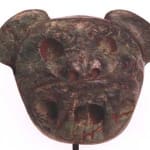Olmec Stone Pendant of a Jaguar's Head, 900 BCE - 500 CE
Stone
2.125
PF.3358
The Olmecs are generally considered to be the ultimate ancestor of all subsequent Mesoamerican civilisations. Thriving between about 1200 and 400 BC, their base was the tropical lowlands of south...
The Olmecs are generally considered to be the ultimate ancestor of all subsequent Mesoamerican civilisations. Thriving between about 1200 and 400 BC, their base was the tropical lowlands of south central Mexico, an area characterized by swamps punctuated by low hill ridges and volcanoes. Here the Olmecs practiced advanced farming techniques and constructed permanent settlements, including San Lorenzo Tenochtitlán, La Venta, Tres Zapotes, Laguna de los Cerros, and La Mojarra. However, the consolidation of their city-states led to notable cultural influence far beyond their heartland, and throughout the Mesoamerican region. This was confirmed in 2005 with the use of NAA (Neutron Activation Analysis) and petrography to demonstrate the spread of Olmec ceramic vessels. It would appear that the Olmec style became synonymous with elite status in other (predominantly highland) groups, with evidence for exchange of artefacts in both directions. A non-literate group, the Olmecs nevertheless paved the way for the development of writing systems in the loosely defined Epi- Olmec period (c. 500 BC). Further innovations include arguably the first use of the zero, so instrumental in the Maya long count vigesimal calendrical system. They also appear to have been the originators of the famous Mesoamerican ballgame so prevalent among later cultures in the region, and either retained or invented several religious symbols such as the feathered serpent and the rain spirit, which persisted in subsequent and related cultures until the middle ages.
Comparatively little is known of their magico-religious world, although the clues that we have are tantalising. The art forms for which the Olmecs are best known, the monumental stone heads weighing up to forty tons, are generally assumed to pertain to some form of kingly leader or possibly an ancestor. The smaller jade figures and celts of which this is one are believed to be domestically or institutionally based totems or divinities. The quality of production is astonishing, particularly if one considers the technology available for production, the early date of the pieces, and the dearth of earlier works upon which the Olmec sculptors could draw. Some pieces are highly stylised, while others demonstrate striking naturalism with interpretation of some facial features (notably down-turned mouths and slit eyes).
This precious pendant is skillfully carved and polished to achieve a glow that accentuates beautiful green hue of the stone. Each facial feature of the jaguar is distinctly carved, with its large mouth displaying the sharp fangs. Its furrowed brows and deep-set eyes not only create a dramatic expression but they also seem to pierce through anything that stands in front of it. Such magnificent sculpture was perhaps worn by an important individual, a chieftain or a ritual performer. The jaguar was one of the most revered animals and was worshipped as a god in Ancient Mesoamerica. As jaguars roamed and ruled the wild jungle, Mesoamericans recognized the prowess of jaguars, attributing magical and divine power to them. As we look into the pendant, we can almost feel the gentle hands of the artist who so lovingly carved the beautiful, intricate sculpture that was worn as a precious jewel.
Comparatively little is known of their magico-religious world, although the clues that we have are tantalising. The art forms for which the Olmecs are best known, the monumental stone heads weighing up to forty tons, are generally assumed to pertain to some form of kingly leader or possibly an ancestor. The smaller jade figures and celts of which this is one are believed to be domestically or institutionally based totems or divinities. The quality of production is astonishing, particularly if one considers the technology available for production, the early date of the pieces, and the dearth of earlier works upon which the Olmec sculptors could draw. Some pieces are highly stylised, while others demonstrate striking naturalism with interpretation of some facial features (notably down-turned mouths and slit eyes).
This precious pendant is skillfully carved and polished to achieve a glow that accentuates beautiful green hue of the stone. Each facial feature of the jaguar is distinctly carved, with its large mouth displaying the sharp fangs. Its furrowed brows and deep-set eyes not only create a dramatic expression but they also seem to pierce through anything that stands in front of it. Such magnificent sculpture was perhaps worn by an important individual, a chieftain or a ritual performer. The jaguar was one of the most revered animals and was worshipped as a god in Ancient Mesoamerica. As jaguars roamed and ruled the wild jungle, Mesoamericans recognized the prowess of jaguars, attributing magical and divine power to them. As we look into the pendant, we can almost feel the gentle hands of the artist who so lovingly carved the beautiful, intricate sculpture that was worn as a precious jewel.



